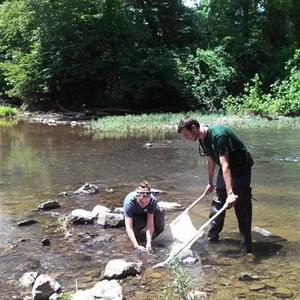By Scott Maxham, IWLA Clean Water Fellow
At a recent water event, someone asked me an intriguing question: “How do I pick my stream monitoring site?”
I could have given the generic, “Well, make sure it’s safe to get in, check if others are monitoring there, pick a spot that’s important to you” type of answer, but I did not. This individual was asking a deeper question: How do I best use my time to monitor at-risk streams?
Government agencies have limited staff and resources to conduct stream monitoring. Some states monitor water quality only where rivers drain into larger bodies of water, such as the Chesapeake Bay or Great Lakes. Other states use computers to randomly generate a list of sites to monitor each year. If one year the computer says to monitor water quality under a highway bridge, that’s where the team goes. But is that water quality information useful? Why not monitor downstream of the bridge? Let’s see what effect the bridge has on water quality. Is urbanization hurting the stream? Well there it is – I put in my human bias. But maybe we need this bias.
Protecting the environment should not mean we simply react to each crisis as it comes up. We need to be proactive in monitoring stream health. Look for a Clean Water Workshop near you to get started!
 It’s critical to have data on water quality today to be able to track how human activities affect it in the future. There are myriad sources of pollution that could harm stream health. Maybe it’s a new housing development or factory going in, a new road being paved, or a forest cut down. Suppose a new natural gas pipeline has been proposed. Should we wait until after it is built and has a suspected leak to monitor nearby streams? No. If we wait, we lose any chance of finding out – and having the data to prove – whether such a change has harmed local streams. It is much easier to keep a healthy stream healthy than it is to spend millions of dollars attempting to bring one back to life.
It’s critical to have data on water quality today to be able to track how human activities affect it in the future. There are myriad sources of pollution that could harm stream health. Maybe it’s a new housing development or factory going in, a new road being paved, or a forest cut down. Suppose a new natural gas pipeline has been proposed. Should we wait until after it is built and has a suspected leak to monitor nearby streams? No. If we wait, we lose any chance of finding out – and having the data to prove – whether such a change has harmed local streams. It is much easier to keep a healthy stream healthy than it is to spend millions of dollars attempting to bring one back to life.
Feeling down that the stream you are monitoring is unhealthy? There is a certain bliss when you monitor a pristine stream. However, finding and documenting degraded streams is equally important – it’s the first step to improving water quality.
Data from the U.S. Environmental Protection Agency shows that across the nation, around 70% of streams are not monitored for water quality. This means it is likely that your local stream needs you to jump in and monitor it. But to be sure, check with your local watershed group and state agencies to see where they are currently monitoring. Agencies such as state departments of natural resources or environmental quality generally publish reports that list monitored stream sites. Some will even have maps of the stream monitoring locations on their website. So do most local watershed groups. Simply searching online for “water quality monitoring” with your state name will yield some good responses. Need more in-depth assistance? Look for a Clean Water Workshop near you!
Still not sure where to monitor? The Izaak Walton League is happy to help. We have been collecting Stream Selfies for the past year – and we collected them for a reason. Users have submitted more than just a friendly face. They answer questions about the stream, including whether it is accessible, can be seen on a map, and looks blatantly degraded. Volunteers have documented hundreds of sites all across the country.
Email sos@iwla.org for help finding a stream monitoring site that works for you.